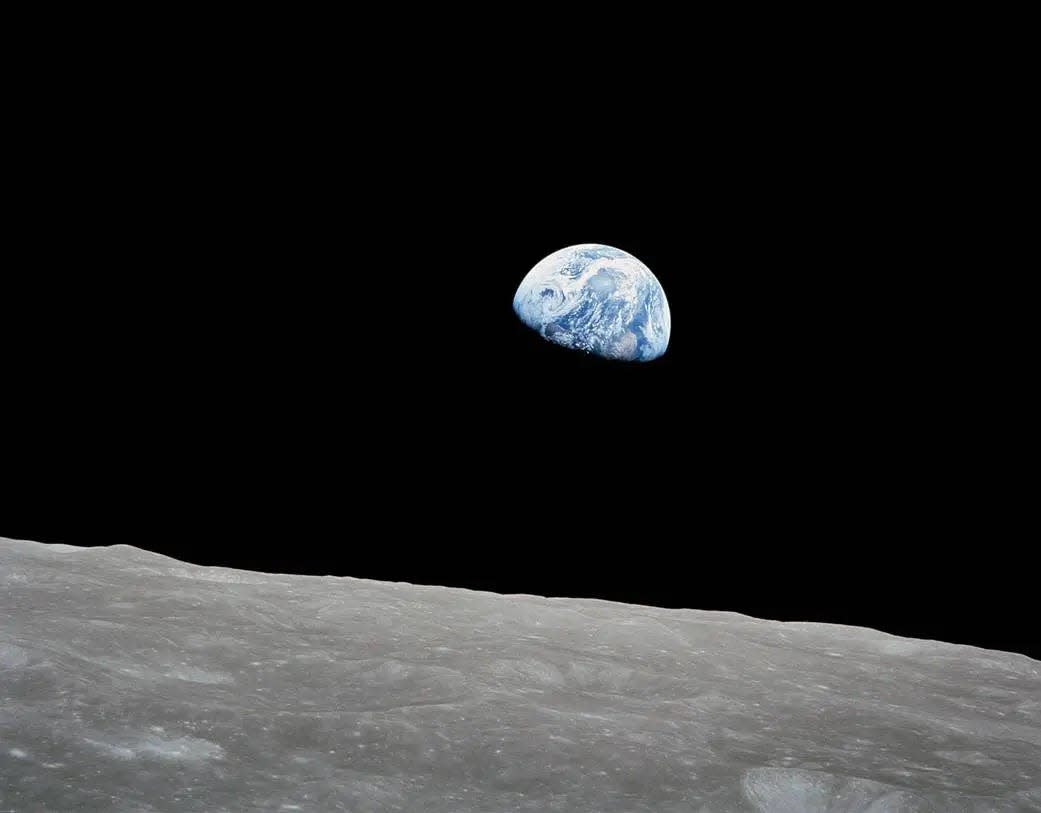Misleading claim that a layer of Earth's atmosphere melts spacecraft | Fact check

The claim: Post implies moon missions impossible because of Earth's atmospheric temperatures
A Nov. 12, 2023, Instagram post (direct link, archive link) suggests that missions to the moon are impossible because a spacecraft couldn't survive the trip through a layer of Earth's atmosphere called the thermosphere.
"Thermosphere temperature range: 500-2,000℃," reads the post.
It then lists purported melting points for metals ? such as aluminum, steel and titanium ? that melt at temperatures less than 2,000 degrees Celsius. It lists the melting point of a "Magic NASA Spaceship Metal" as "Unknown."
"Humans went to the moon?" reads the post. "Are you sure about that?"
The post garnered more than 100 likes in less than three months.
More from the Fact-Check Team: How we pick and research claims | Email newsletter | Facebook page
Our rating: Missing context
The implied claim is wrong. Thermospheric temperatures do not melt spacecraft. While this layer of the atmosphere does technically reach the temperatures stated in the post, there are not enough air molecules in the thermosphere to transfer significant amounts of this heat to an object, according to researchers.
Spacecraft don't melt from thermosphere temperatures
The ramifications of a high temperature, such as 2,000 degrees Celsius, are different at sea level than in the thermosphere, according to Rona Oran, a Massachusetts Institute of Technology plasma physicist.
"The temperature of the air is basically a measure of how fast ? on average ? (air) molecules move with respect to each other," she said.
On a hot day at sea level, a person experiences the warmth of the surrounding air because many fast-moving air molecules are striking the person's body.
"This is called 'heat transfer,'" Oran said. "We need those molecules to bump into us to feel the ambient heat of the air around us."
However, the density of air molecules is very low in the thermosphere, which is considered to be in "outer space," according to Oran.
A temperature of 2,000 degrees Celsius would "literally not be felt by anyone in those altitudes," she said. "The reason is that there are not enough air molecules to bump into us. Nothing would melt."
Brewing a cup of tea can help demonstrate why the post is misleading, Noah Petro, a project scientist for the NASA Lunar Reconnaissance Orbiter, told USA TODAY.
"I just had a cup of tea and when the water was boiling, the steam coming off the kettle reminded me of (the thermosphere)," he said in an email. "The steam coming off the kettle is near the boiling temperature, 212 degrees Fahrenheit, but because the steam is spread over a larger space, I can put my hand in there and not get burned. In space, the hot atoms are spread even further apart!"
Fact check: Flat Earth claim misrepresents purpose of Apollo lunar module
The post was captioned with a series of hashtags related to flat Earth theory ? the errant idea Earth is flat instead of roughly spherical. Flat Earth theory adherents often leverage purported inconsistencies in scientific narratives to wrongly claim that space travel is impossible.
There is an abundance of evidence that the NASA Apollo missions survived the trip through the thermosphere and traveled to the moon, including the hundreds of pounds of lunar rocks and samples returned to Earth, photos and videos captured by astronauts on the moon, modern satellite photos of lunar vehicle tracks and other mission artifacts and ongoing data collection from devices astronauts left on the moon.
Additionally, the International Space Station and SpaceX Starlink communications satellites successfully orbit Earth within the thermosphere.
USA TODAY reached out to the Instagram user who shared the post for comment but did not immediately receive a response.
Our fact-check sources:
Rona Oran, Jan. 2-7, Email exchange with USA TODAY
Noah Petro, Jan. 2, Email exchange with USA TODAY
Scientific American, March 27, 2020, Flat Earthers: What They Believe and Why
Humboldt State University, accessed Feb. 6, The Earth is Not a Sphere! It's an Ellipsoid
NASA, accessed Feb. 6, The Apollo Program
NASA, May 13, 2019, Shrinking Moon May Be Generating Moonquakes
NASA, accessed Feb. 6, Weather on the Moon
NASA Space Place, accessed Feb. 6, Thermosphere
NASA Vital Signs of the Planet, Oct. 2, 2019, Earth's Atmosphere: A Multi-layered Cake
University Corporation for Atmospheric Research, accessed Feb. 6, The thermosphere
University Corporation for Atmospheric Research, March 31, 2021, The Lower Fringes of Outer Space: The Thermosphere & Ionosphere
Arizona State University, accessed Feb. 6, Apollo landing sites
National Air and Space Museum, accessed Feb. 6, Lunar rocks
NOAA, accessed Feb. 6, Layers of the Atmosphere
Thank you for supporting our journalism. You can subscribe to our print edition, ad-free app or e-newspaper here.
USA TODAY is a verified signatory of the International Fact-Checking Network, which requires a demonstrated commitment to nonpartisanship, fairness and transparency. Our fact-check work is supported in part by a grant from Meta.
This article originally appeared on USA TODAY: Thermosphere temperature doesn't melt spacecraft | Fact check
